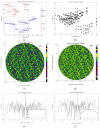Multi-Objective Design and Optimization of Hardware-Friendly Grid-Based Sparse MIMO Arrays
- PMID: 39517707
- PMCID: PMC11548793
- DOI: 10.3390/s24216810
Multi-Objective Design and Optimization of Hardware-Friendly Grid-Based Sparse MIMO Arrays
Abstract
A comprehensive design framework is proposed for optimizing sparse MIMO (multiple-input, multiple-output) arrays to enhance multi-target detection. The framework emphasizes efficient utilization of antenna resources, including strategies for minimizing inter-element mutual coupling and exploring alternative grid-based sparse array (GBSA) configurations by efficiently separating interacting elements. Alternative strategies are explored to enhance angular beamforming metrics, including beamwidth (BW), peak-to-sidelobe ratio (PSLR), and grating lobe limited field of view. Additionally, a set of performance metrics is introduced to evaluate virtual aperture effectiveness and beamwidth loss factors. The framework explores optimization strategies for the partial sharing of antenna elements, specifically tailored for multi-mode radar applications, utilizing the desirability function to enhance performance across various operational modes. A novel machine learning initialization approach is introduced for rapid convergence. Key observations include the potential for peak-to-sidelobe ratio (PSLR) reduction in dense arrays and insights into GBSA feasibility and performance compared to uniform arrays. The study validates the efficacy of the proposed framework through simulated and measured results. The study emphasizes the importance of effective sparse array processing in multi-target scenarios and highlights the advantages of the proposed design framework. The proposed design framework for grid-spaced sparse arrays stands out for its superior efficiency and applicability in processing hardware compared to both uniform and non-uniform arrays.
Keywords: adaptive desirability function; array design and optimization; grating lobe-free arrays; grid-based sparse MIMO arrays; machine learning; mitigation of mutual coupling; sidelobe reduction.
Conflict of interest statement
The authors declare no conflicts of interest.
Figures
























References
-
- Zheng Z., Wang W., Kong Y., Zhang Y.D. MISC array: A new sparse array design achieving increased degrees of freedom and reduced mutual coupling effect. IEEE Trans. Signal Process. 2019;67:1728–1741. doi: 10.1109/TSP.2019.2897954. - DOI
-
- Krim H., Viberg M. Two decades of array signal processing research: The parametric approach. IEEE Signal Process. Mag. 1996;13:67–94. doi: 10.1109/79.526899. - DOI
-
- Liao B., Madanayake A., Agathoklis P. Array signal processing and systems. Multidim. Syst. Sign. Process. 2018;29:467–473. doi: 10.1007/s11045-018-0555-7. - DOI
-
- Catreux S., Driessen P.F., Greenstein L.J. Data throughputs using multiple-input multiple-output (mimo) techniques in a noise-limited cellular environment. IEEE Trans. Wirel. Commun. 2002;1:226–235. doi: 10.1109/7693.994816. - DOI
-
- Chen Z., Yan F., Qiao X., Zhao Y. Sparse Antenna Array Design for MIMO Radar Using Multiobjective Differential Evolution. Int. J. Antennas Propagat. 2016;2016:1747843. doi: 10.1155/2016/1747843. - DOI
Grants and funding
LinkOut - more resources
Full Text Sources

